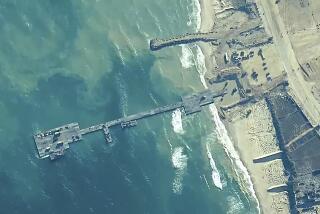Moving mountains of war gear home from Afghanistan
- Share via
FT. BRAGG, N.C. — For the last 11 years, the U.S. military has stuffed bases in Afghanistan with Humvees and bullets, radios and radars, armored vehicles and surveillance balloons. Army Maj. Gen. Kurt Stein has less than two years to move $48-billion worth of weapons, gear and equipment back home.
Before U.S. combat troops leave at the end of 2014, Stein has to figure out how to transport 35,000 vehicles, 95,000 shipping containers and mountains of other war materiel out of a landlocked, mountainous country in the middle of a war.
It’s not the first monumental moving job for Stein, 54, a burly former enlisted man with 37 years experience in military logistics. He was a top commander of the massive effort to move gear and equipment out of Iraq two years ago.
“Hard but not that hard,” Stein said of moving tons of materiel on paved Iraqi highways into relatively safe and orderly Kuwait. “Afghanistan? Big difference. We don’t have the road networks or the ports.”
There’s one more thing: Stein doesn’t know how much stuff to leave behind, if any, because he doesn’t know how many troops will remain after 2014, if any. That is still being negotiated by the U.S. and Afghanistan, with a target date of November 2013.
“All we can do now is get after what we know today,” he said. The rest, he said, “depends on the end state, which we certainly don’t know.”
Stein estimates moving the materiel will cost taxpayers about $6 billion. The job is being tackled by more than 86,000 people, military and civilian, under his command.
Stein is technically deployed to Afghanistan, but he commutes to Ft. Bragg. Chronically jet-lagged, Stein lives on Afghan time, starting work at 4:30 a.m. at Ft. Bragg to stay in sync with operations in Afghanistan. Clocks on his office wall are set to times in North Carolina, Greenwich Mean Time, Iraq and Afghanistan.
He hasn’t had time to finish setting up his office here because he’s usually traveling — his territory covers 6 million square miles. He took command on a Friday last June, then flew to Afghanistan the following Monday.
Until last month, Stein spent millions of extra dollars to fly out gear and equipment because Pakistan would not guarantee truck passage through the Khyber Pass to Pakistani ports. After lengthy negotiations with U.S. officials, Pakistan agreed in mid-February to allow daily ground shipments across the border, but it could still close the crossing at any time.
Trucks are carrying materiel to Pakistani ports, where it is shipped to the U.S. Separately, military aircraft and contracted civilian planes are taking some materiel to ports in Jordan, Dubai and Oman, where containers are loaded onto ships headed to U.S. ports. From there, goods are trucked to military depots and arsenals around the country.
In the meantime, Stein has to continue to pour in supplies, weapons and ammunition, plus food and water, to the 66,000 U.S. troops still manning bases and outposts in the 11-year-old war. The stuff coming in crosses paths with the stuff going out. About 1,500 vehicles and 1,000 cargo containers exit Afghanistan monthly.
U.S. forces have shut down or turned over to Afghan forces 619 bases and combat outposts, with 193 still to be handed over or dismantled. All that equipment has to go somewhere. Some — portable toilets, concrete barriers, vehicles, modular housing — is going to Afghan security forces because it costs more to ship than it’s worth. Other stuff — wood and metal from temporary buildings and barriers, plus old vehicles and trailers — is being crushed and sold to Afghans as scrap.
Some of the stuff is just plain worn out and will be destroyed. “The Afghans don’t want junk, either,” Stein said.
More to Read
Sign up for Essential California
The most important California stories and recommendations in your inbox every morning.
You may occasionally receive promotional content from the Los Angeles Times.











